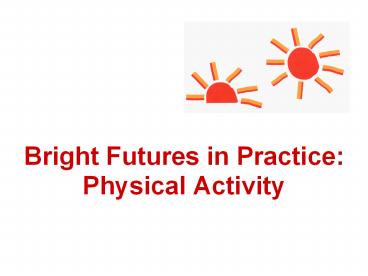Bright Futures in Practice: Physical Activity PowerPoint PPT Presentation
Title: Bright Futures in Practice: Physical Activity
1
- Bright Futures in Practice Physical Activity
2
New Morbidities of the 21st Century
- Changing family structures
- Highly mobile populations
- Lack of access to health care
- Health disparities
- Deteriorating neighborhoods and communities
- Intentional and unintentional injuries, substance
abuse, depression, and HIV infection
3
Bright Futures Sponsors
4
- Every Child Deserves a Bright Future!
5
The Mission of Bright Futures
- To promote and improve the health and well-being
of infants, children, adolescents, families, and
communities. Bright Futures is dedicated to
developing educational materials for health
professionals, families, and communities
implementing Bright Futures content, philosophy,
and materials and fostering partnerships and
collaboration.
6
Bright FuturesAn Organized Structure for Health
Supervision
- Bright Futures provides a framework to address
the - current and emerging health needs of infants,
- children, adolescents, and their families.
7
Bright Futures GuidelinesCornerstone Document
8
Fluoridation
Immunizations
Health Promotion/Prevention Works!
Bike Helmets
Back to Sleep
9
(No Transcript)
10
Partnerships Make a Difference
- Health professionals
- Families
- Child care professionals
- Social service professionals
- Schools
- Local and state government
- Community groups
- Business/industry
- Faith communities
- Payers
11
Bright Futures in Practice Series
- Oral Health
- Nutrition
- Physical Activity
- Mental Health
12
Physical Activity Trends
- Daily attendance of high school students in
physical activity classes declined from 42 in
1991 to 25 in 1995 - Nearly half of adolescents (12-21) did not
participate regularly in vigorous physical
activity - Participation in physical activity declines
strikingly as age or grade in school increases - Children and adolescents with certain health
conditions are less likely to engage in moderate
or vigorous physical activity than other children
and adolescents
13
Bright Futures in PracticePhysical Activity
- Vision and Goals
- Improve the health and physical activity status
- Establish health supervision guidelines focusing
on physical activity - Increase families knowledge, skills, and
participation in developmentally appropriate
physical activities - Encourage partnership among health professionals,
families, and communities
14
Organizations That Support Bright Futures in
Practice Physical Activity
- American Academy of Family Physicians
- American Academy of Pediatrics
- American Dietetic Association
- American School Health Association
- National Association for Sport and Physical
Education - National Association of Pediatric Nurse
Practitioners - and many more
15
How the Guide is Organized
- Introduction
- Developmental Chapters
- Issues and Concerns
- Tools
- Indexes
16
Introduction
- Surgeon Generals Report on Physical Activity and
Health - Benefits of Physical Activity
- Building Partnerships
17
Developmental Chapters
- Infancy011 Months
- Early Childhood14 Years
- Middle Childhood510 Years
- Adolescence1121 Years
18
Developmental Chapters
- Highlights
- Overview of developmental period
- Strengths, and issues and concerns
- Physical activity supervision
19
Developmental Chapters
- Highlights
- Desired outcomes
- Vignette
- Frequently asked questions
20
Issues and Concerns Chapters
- Asthma
- Children and Adolescents with Special Health Care
Needs - Ergogenic Aids
- Heat-related Illness
- Injury
- Obesity
21
Tools
- Definitions
- Characteristics of Excellent Physical Activity
Programs - Characteristics of Excellent Coaching
- Physical Activity Resources
- CDC Growth Charts
22
How the Guide Can Be Used
- Clinical settings
- Community setting
- Policy
- Education and Training
23
How the Guide Can Be Used Clinical
- Incorporate information into each health
supervision visit - Develop and evaluate physical activity programs
- Implement standards of practice and protocol
- Educate children, adolescents, and their families
24
How the Guide Can Be Used Community
- Provide anticipatory guidance to families on
developmentally appropriate physical activity - Develop physical activity programs
- Help schools incorporate physical activity
education - Implement standards of practice and protocol
25
How the Guide Can Be Used Policy
- Provide information to policymakers, program
administrators, and community leaders on relevant
physical activity issues and concerns - Obtain support for physical activity policies and
programs
26
How the Guide Can Be Used Education and Training
- Educate and train health professionals and
paraprofessionals - Provide in-service education and training to
staff - Use as a textbook or reference
27
Bright Futures Web Sitewww.brightfutures.org
- Resources for health professionals and families
- View, download and order publications
28
Bright Notes
29
To find out more about Bright Futures, contact
- Bright Futures Project
- National Center for Education
- in Maternal and Child Health
- Georgetown University
- 2000 15th Street, North, Suite 701
- Arlington, VA 22201-2617
- Tel (703) 524-7802
- Fax (703) 524-9335
- E-mail BrightFutures_at_ncemch.org

